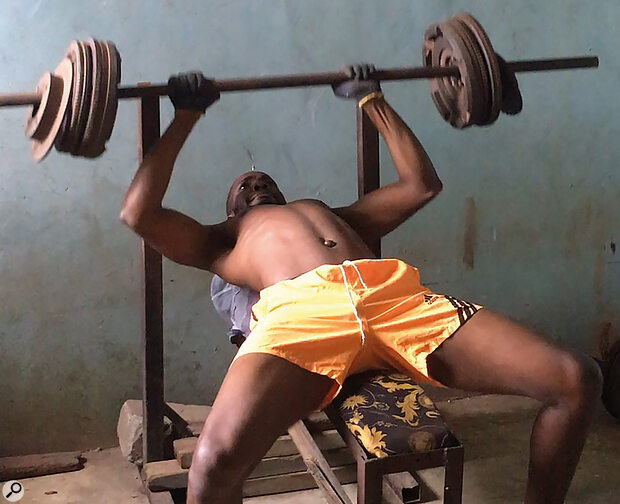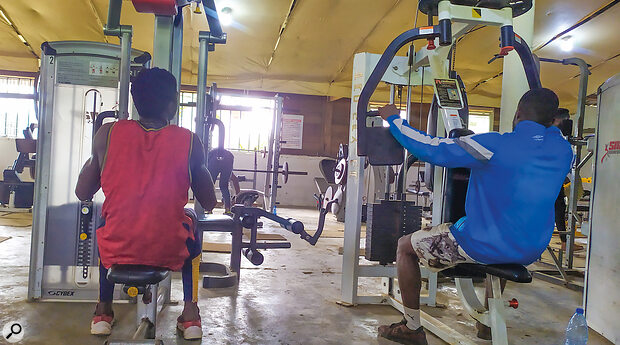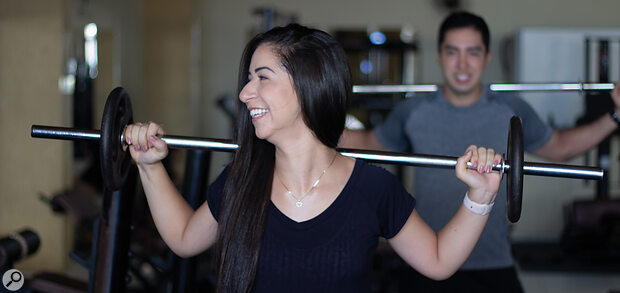 Occupations don’t get much more sedentary than sitting at a console all day.
Occupations don’t get much more sedentary than sitting at a console all day.
When our job involves a lot of sitting down, it’s up to us to inject some movement into our lives.
“Twelve hours of sitting in a chair doesn’t make a person more creative,” says Tim Bazell. “We need to move, we need to be in the world, with our senses engaged.”
“The long hours, inconsistent income and sedentary lifestyle can take a huge toll on your mental and physical health,” agrees Sean Genockey.
In this series of articles, we’re looking at the worrying decline in our baseline level of health, focusing on the obstacles presented by a job in the world of audio. The first three parts focused on sleep, stress and nutrition, and we’ll conclude this month with movement.
While there are some setup days where studio engineers can be extremely active, never sitting down for a moment, for the most part that’s not the case. As tracking gives way to overdubs, editing and mixing, the job tends to become increasingly sedentary. The engineer can bear the brunt of this, sometimes finding themselves at the desk for hours without a break.
Music & Movement
We hear a lot about the dangers of a sedentary lifestyle, but why does movement actually matter? It’s all to do with the health of our skeletal muscle: the big motor units that we have under our conscious control. Not only do they move us around, but they play a crucial role in our metabolic health.
When our blood sugar rises after a meal, our muscle mass acts as a soak, topping up its stores of glycogen — the storage form of glucose. The more muscle we have, and the more we use that muscle, the better it can protect us against the harms of high blood sugar. When we move our muscle, we deplete glycogen and release myokines, signalling molecules that help with the uptake of glucose from the blood.
Conversely, if we’re sedentary, our muscle mass shrinks, and begins to store fatty acids, which make it insulin‑resistant. The inactive muscle refuses to take up blood glucose, which must be sent back to the liver where it can be turned into fat, packaged into lipoprotein particles, and sent to our adipose tissue. Over time, fat begins to accumulate in the liver itself in a condition called Non‑Alcoholic Fatty Liver Disease (NAFLD). The liver in turn becomes insulin‑resistant: it stops listening to insulin’s message that there’s plenty of glucose already available in the blood. It continues to release its own stores of glucose, breaking down muscle tissue to create more.
It’s a perfect storm. What we need is more movement, more muscle mass and less surplus blood glucose, but what we wind up with is muscle being broken down to fund the creation of blood sugar that we don’t need. This is why diabetics have high blood sugar, even when they haven’t yet eaten. Non‑Alcoholic Fatty Liver Disease, which is worsened by the excessive consumption of fructose from soft drinks and processed food, represents a crucial stepping stone in the path to Type 2 diabetes. It affects nearly 40 percent of adults worldwide, and shockingly, 5‑10 percent of children in the US.
Stress makes this whole cascade worse as cortisol affects our insulin sensitivity. We start to see symptoms like irritability, weakness and shakiness when a meal is delayed or missed, tiredness, cravings for sugary or salty foods, fatigue in the afternoons and fat around our mid section and face. These indicators, which we so readily accept as normal, are a red flag: a warning that our metabolic health is on the ropes.
The ‘E’ Word
Luckily, this is something that isn’t terribly difficult to improve. We talked last month about getting rid of processed food and drinks, and now we turn our attention to movement. When we move our skeletal muscle, we prevent that storage of fat in the muscle mass, deplete glycogen reserves and so increase our capacity to store blood sugar. If we can move in such a way that actually builds more muscle, we further increase that capacity, as well as increasing our basal metabolic rate: the number of calories we burn just sitting in front of the console, or at the computer.
To many of us, ‘exercise’ means hours of arduous torture on machines that lie to you about how many calories you’ve burned...
In all this discussion of movement, you may notice that I’m avoiding the word ‘exercise’, the connotations of which are horrible. To many of us, ‘exercise’ means hours of arduous torture on machines that lie to you about how many calories you’ve burned, attempts to watch Netflix on a tiny phone screen with your noise‑cancelling AirPods no match for the PA blasting Skrillex and Eminem, and the Myzone heart rate display on the gym wall detailing the infinitely superior efforts of your fellow cardio bunnies. Perhaps you eschew the gym entirely for brutal early‑morning runs on knees that seem to be designed for almost anything else. If you’re getting a sinking feeling just thinking about it, quite right — it’s all awful.
Some of us love running, and I’m not necessarily trying to discourage that. Indeed, if we really want to be fit in every possible sense, to maximise every benefit that exercise has to offer the human body, we will need to include cardiovascular exercise at a variety of intensities, from endurance work all the way through to very high‑intensity, ‘best effort’ interval training. That doesn’t mean we have to run, but it does mean that we’d be spending at least some of our time undergoing what most of us think of as ‘exercise’. If we’re lucky we can mask the misery by doing this in the form of a sport or game that we enjoy. But here’s my point: If our time is limited, if we’re not in love with the idea of sweating our lives away on the treadmill, and if we’re simply not going to do this if that’s what it involves, there are ways we can move which will give us more ‘bang for the buck’, more return on our investment of time and effort.
The first thing is to understand our goals. We are looking to break up the sedentary hours sat at the computer, to move frequently throughout the day, and to maintain the volume and function of our lean body mass — those parts of us that are not devoted to fat storage. The problem with endurance running is that it tends to confine our daily movement to one condensed period of time, when what we really need is consistent, regular movement throughout the day. Endurance exercise also drives an adaptation that favours efficiency and a reduction in muscle mass. Long‑distance runners are skinny. What we need, what will suit our requirements is to actually be less efficient with energy, and to build more metabolically active lean mass.
So, if not running, then what?
Walk!
 A change as simple as walking to work instead of driving or getting the bus can make a big difference to your overall health.Walk for transport. Walk immediately after meals. Walk for 10 minutes. Walk around the block. Walk and talk. Walk if you need to make a call. Walk to clear your head. Walk to rest your ears. Just taking three 10‑minute walks per day, after meals, clocks up nearly 550 miles per year! If you’re sedentary at the moment, and you do this and only this, you’re making a huge difference to your health.
A change as simple as walking to work instead of driving or getting the bus can make a big difference to your overall health.Walk for transport. Walk immediately after meals. Walk for 10 minutes. Walk around the block. Walk and talk. Walk if you need to make a call. Walk to clear your head. Walk to rest your ears. Just taking three 10‑minute walks per day, after meals, clocks up nearly 550 miles per year! If you’re sedentary at the moment, and you do this and only this, you’re making a huge difference to your health.
Walking proved to be an essential activity for many of the engineers and producers I spoke to. Jim Homes states: “If a band is feeling lethargic, we take them for a walk around the block. It’s a much better dopamine hit than a bar of Cadbury’s. We take time away from the studio as much as we can afford to. We can get out into nature very easily and we do, all the time. It’s powerful.”
Sean Genockey walks every day, and Emre Ramazanoglu explains: "I take constant breaks, and try to go outside at least a couple of times a day. I walk to work, four to six miles each way depending on my route.”
We don’t need to cover 12 miles a day if we don’t want to, though. The typical 10,000‑step goal is a good one. In fact a recent study identified optimal outcomes at 8800 steps per day.
Lift Heavy Things
If we’re after a form of movement that takes little time, builds and maintains muscle, protects our metabolic health and increases our mobility, function and physical robustness as we move past middle age, we need look no further than strength training. Even 30 minutes of resistance exercise, twice a week, is enough to improve every marker of metabolic health. To protect us from age‑related muscle loss and osteoporosis, we need to build lean mass, and we need to do it now.
To protect us from age‑related muscle loss and osteoporosis, we need to build lean mass, and we need to do it now.
I fully appreciate that there are barriers to beginning a strength training practice for the first time. Some of us are not going to take that step, regardless of how much it might benefit us. While I’d strongly encourage anyone to give it a try before dismissing the idea entirely, if walking is what you’re able to do, that’s a huge step (no pun intended). Other than simply not wanting to, what are our barriers to entry when it comes to strength training, and what can we do about them?
We’re going to need to join a gym, and to learn some new skills. Some of us will need to overcome our preconceptions about gyms, about the judgement we believe we will be subjected to there. Many of us don’t see ourselves as ‘gym people’. I’ve been training in commercial gyms for decades, everything from expensive London ‘health clubs’ to boxing gyms where most of the weights look like they’ve been put together from bits of old cars. In that time, I’ve found it’s extremely rare for anyone to look down on a fellow member for their lack of fitness, ability or physical condition. It tends to be the largest, scariest individuals who most fiercely defend the right of anyone and everyone to use the gym, and who most generously give their time if ever asked for help. The less comfortable someone appears to be at first, the more they will be respected for making the effort.
Men tend to be less strong than they think they are. Women tend to be far, far stronger than they think they are. There’s no point in measuring ourselves against others in this context. With the exception of two people in the world, we are all stronger than someone, and weaker than someone. In my case, the person I’m weaker than often proves to be half my size, and a girl. The only comparison worth making is you today vs you yesterday.
Strength training need not be time‑consuming. We are not trying to burn calories, but rather to send a message to our central nervous system. It’s a message that says: "I need to be strong, I need more muscle, and I need it to work well.” The best way to send this message in a short time is to lift fairly heavy, focusing on a small number of big, compound movements — those that use multiple joints. We may need some help to learn correct technique for these lifts, but these are important skills that will serve us for the rest of our lives. There are people in their 80s performing these lifts in my local gym. They look like they’re 65.
 Gyms, and their users, come in all shapes and sizes. Don’t be intimidated!
Gyms, and their users, come in all shapes and sizes. Don’t be intimidated!
The best gym is the one you can get to. It’s no good joining an incredible gym that’s so far away that you can’t make it over there. Find your nearest gym and go in. Get the tour. Just see what it’s all about. If you have a choice of gyms within easy reach, look for one that seems to prioritise strength work. Do they have a lot of squat racks, barbells, and lifting platforms, rather than acres of cardio machines? Is it full of the sort of people that look like they strength train at a high level? If so, great.
Strength work can sometimes be intense, but much of the time we are simply popping into the gym to practise our lifts for a little while. We are often playing, enjoying what our bodies are capable of, enjoying making them move. This need not be sweaty and arduous. It can be fun!
Stay Well
This series is not intended to be definitive, or exhaustive. I hope that it represents the opening of an expanding conversation, as more industry professionals and organisations engage to offer their perspectives. In the meantime, as Jerry Springer would say, look after yourselves, and each other.
Better, Not Bigger
Many people, especially women, are worried that strength training may make them ‘bulky’. While it’s encouraging to see that the painfully thin ‘size zero’ imagery that has caused such harm over recent decades is slowly starting to be balanced by stronger‑looking phenotypes, it’s still the case that many of us would prefer to be physically small. Rest assured that by doing strength training, by increasing lean mass, we are likely to get stronger and smaller: we lose inches as our body fat percentage drops. It may be that our scale weight increases as bone density and muscle mass increase, but we will typically shrink. The idea that we will pile on a significant volume of visible muscle is a myth: It’s incredibly hard to build a lot of muscle, and we’re not going to do it by accident. Even men, with their relatively greater propensity for anabolism, will only gain a lot if they’re using drugs or are particularly genetically gifted. In the case of really huge people, it’s both. Don’t confuse the ‘pump’ that you might experience for a short time after training for a permanent increase in muscle size.
Make Certain
The recommendations made in this article will benefit the large majority of people, but be aware that there may be reasons why some of us should not exercise in certain ways, or at certain intensities. We recommend that you get the go‑ahead from your doctor before undertaking an exercise program.



